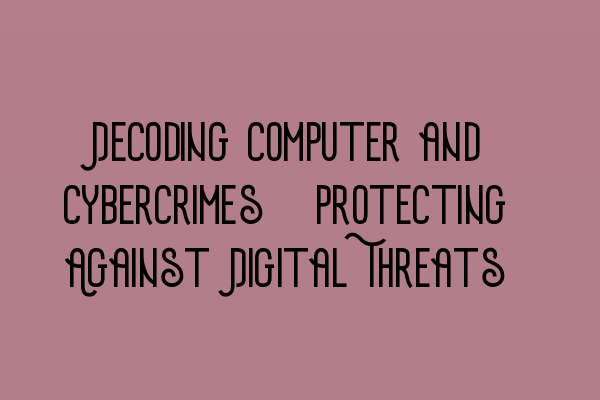Decoding Computer and Cybercrimes: Protecting Against Digital Threats
Welcome to the SQE Criminal Law & Practice Law UK blog! In today’s digital age, computer and cybercrimes have become a significant concern for individuals and businesses alike. With the increasing reliance on technology, it is crucial to understand these threats and take proactive measures to protect ourselves from them. In this blog post, we will delve into the world of computer and cybercrimes, decode their complexities, and provide you with essential tips to safeguard against digital threats.
What are Computer and Cybercrimes?
Computer and cybercrimes refer to illegal activities conducted through electronic devices and the internet. These crimes encompass a wide range of offenses, including hacking, identity theft, phishing, malware attacks, and online scams. Perpetrators of these crimes exploit vulnerabilities in computer systems, networks, and software to gain unauthorized access, steal sensitive data, or disrupt operations.
As technology continues to advance, cybercriminals have become more sophisticated and creative in their approaches. They employ various techniques, such as social engineering, ransomware, and advanced persistent threats, to target individuals, businesses, and even governments. The consequences of computer and cybercrimes can be severe, leading to financial losses, reputational damage, and violations of privacy.
Understanding the Implications
In today’s interconnected world, the implications of computer and cybercrimes extend beyond financial losses. They can disrupt critical infrastructure, compromise national security, and cause significant harm to individuals and societies. It is, therefore, crucial to be aware of these implications and take necessary precautions to minimize the risks involved.
How to Protect Against Cyber Threats
Protecting against computer and cybercrimes requires a multi-layered approach that combines technology, awareness, and proactive measures. Here are some key steps you can take:
- Keep Your Software Up to Date: Regularly update your operating system, antivirus software, and other applications to patch vulnerabilities and protect against the latest threats.
- Use Strong Passwords: Create unique and complex passwords for all your online accounts. Consider using password management tools to securely store and manage your credentials.
- Enable Two-Factor Authentication (2FA): Add an extra layer of security by enabling 2FA on your accounts. This requires a second form of authentication, such as a fingerprint scan or a unique code sent to your mobile device.
- Be Cautious of Phishing Attempts: Be wary of suspicious emails, messages, or calls asking for personal information. Always verify the sender’s identity before sharing any sensitive data.
- Avoid Clicking on Suspicious Links: Be cautious when clicking on links in emails or messages, especially if they appear to be from unknown sources. Hover over the link to view the actual URL before clicking.
- Use a Firewall: Install a reliable firewall to monitor and filter incoming and outgoing network traffic. This helps prevent unauthorized access to your device.
- Backup Your Data: Regularly backup your important files and data to an external hard drive or cloud storage. This ensures that you can recover your data in the event of a security breach or system failure.
By implementing these best practices, you can significantly reduce the risk of falling victim to computer and cybercrimes. However, it is important to note that cybersecurity is an ongoing process. Stay updated on the latest threats and trends in order to adapt your security measures accordingly.
Conclusion
Computer and cybercrimes pose a significant challenge in our digital society. By understanding these threats and taking proactive steps to enhance cybersecurity, we can protect ourselves and our organizations from potential harm. Stay vigilant, educate yourself and others, and together we can create a safer digital environment.
We hope you found this blog post informative and valuable. For more resources and information on related topics, please visit the following articles:
